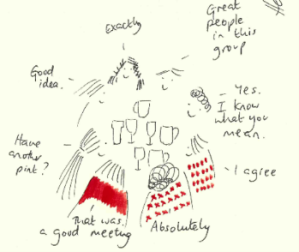I had one more opportunity to volunteer at PMI Silicon Valley chapter this week. During our breakout session, one of the project managers described problems he was having with his team members. He was describing how team members are having conflicts during meetings and their impact on the project. After further discussions with this project manager, I realized that proper team agreements were not defined by this team and that could have avoided many of these conflicts.
Today, I’m going to talk about the importance of team agreements. To describe the problem, allow me set up the scene where a project meeting is taking place.
 The project manager was having an important meeting with stakeholders. It was during the planning phase of the project. The discussion was about the requirements provided by stakeholders. Some of these requirements conflicted with each other. Some requirements needed to be eliminated to keep the project in the confines of its defined scope.
The project manager was having an important meeting with stakeholders. It was during the planning phase of the project. The discussion was about the requirements provided by stakeholders. Some of these requirements conflicted with each other. Some requirements needed to be eliminated to keep the project in the confines of its defined scope.
Various stakeholders felt very strongly to keep their requirements. There were intense arguments made by multiple stakeholders. After about 20 minutes into the meeting, three key stakeholders abruptly got up and walked out of the meeting. This similar thing kept happening for the next several meetings. The requirement analysis phase of the project was finally completed but the team did not function well together after that. This experience left the members frustrated, with bad feelings, and it caused jurisdictional divides.
This is a real-life scenario that occurred on one of the corporate wide IT projects that I participated in as a stakeholder some years ago. What went wrong in the situation? What could have helped to avoid these issues?
The answer is the project needed team agreements. If there were proper team agreements defined and utilized as part of the planning process, many of these problems could have been avoided.
The team agreement is an effective way to address such issues. If a team creates a set of team agreements on how to function when difficult issues arise, they will be much better equipped to handle internal disagreements and challenges much easier when they occur. Team agreements provide guidance and direction on how the team will communicate in difficult situations.
The critical part of a successful team environment is making sure everyone has the same vision before moving into action. The classic “forming–storming–norming–performing” stages that teams go through are best managed when a team has a standard set of agreements. The team agreements serve the norming function as members of the team agree on how they will work with each other in general. The agreement should also provide guidelines and strategy in resolving their “storming” issues when they come up.
The team agreements can be utilized on projects using SCRUM as well. You should continue to maintain team agreements and update them as the outcome of retrospectives. The refined team agreements can be used in subsequent sprints. This is an important step in the evolution of ‘just a group of people’ to a SCRUM team.
One of the most important tasks in early meetings is to sign off on a team agreement that clearly defines your expectations for each other, your operating parameters, and the ways in which you will define success at the end of the project. There are numerous ways to create a team agreement. The main idea is to keep it simple and real. It should be defined by the team, not just by the project manager. All team members should work together to identify 3-5 things they believe they can do to support each other while working towards their goals. They might come up with items such as “active participation” and “communication”.
 Soft skills and interpersonal behaviors should also be identified that each member agrees to practice. Make sure each team member signs off on a final document. Some teams agree to this by demonstrating a show of hands, others retain a document that includes the list of members, agreements and could also include their brainstorming notes. This step enforces accountability with each other and the project manager. Some teams have their agreement printed up and post near their offices or conference room.
Soft skills and interpersonal behaviors should also be identified that each member agrees to practice. Make sure each team member signs off on a final document. Some teams agree to this by demonstrating a show of hands, others retain a document that includes the list of members, agreements and could also include their brainstorming notes. This step enforces accountability with each other and the project manager. Some teams have their agreement printed up and post near their offices or conference room.
I have included a sample set of team agreements to use or to help you compose your own.
- Have open communication and active participation
- Utilize lessons learned from experience
- Treat all team members with respect and value for other team member’s opinion and time
- Be a leader – have a sense of ownership in what you and your team are doing
- Respect others’ views/thoughts and appreciate contribution
- Resolve all conflicts positively
- Hold yourself accountable
- Define the operating parameters within which to conduct meetings
- All formal meetings have an agenda and have one conversation at a time during the meeting
There are number of benefits of creating team agreements.
 The team agreements help team members work together in a way that truly honors each other. It helps the team easily return to a sense of aligned purpose when team experiences the inevitable challenges of working issues on any project. It ensures everyone on the team is aware of the expectations of the group.
The team agreements help team members work together in a way that truly honors each other. It helps the team easily return to a sense of aligned purpose when team experiences the inevitable challenges of working issues on any project. It ensures everyone on the team is aware of the expectations of the group.
It creates a foundation for building trusting relationships, which strengthens the team’s infrastructure. It provides a forum for open communication. It also ensures each team member is accountable to their team.
What’s more? Having the team agreements can help your team eliminate assumptions about what’s expected of everyone. This helps the team increase trust and performance. A highly functioning team is the key for a successful project, and as a leader, you can help the team set the foundation for success! The ultimate role model for the agreement is the team leader. Talk about it, refer to it and most importantly, use it!

Thanks Ainsley. I am glad you liked the article. I agree with you comments. It’s important to keep them as part of team Charter.
I agree completely about the importance and usefulness of team Working Agreements. I always include Working Agreements when kicking-off a new project or team. Since WAs are most often focused on operational issues, I also make sure we have time to develop team principles to guide decision-making. I include Working Agreements and Principles in project and team Charters, along with the Vision, Mission, measurable Objectives, etc. Good article!